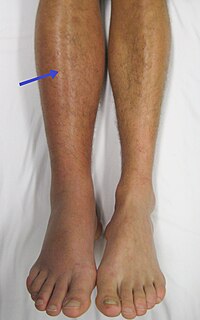
Photo from wikipedia
PURPOSE OF REVIEW Two major complications compromise the outcomes and quality of life for left ventricular assist device (LVAD) patients. This review aims to discuss the mechanisms of thrombosis and… Click to show full abstract
PURPOSE OF REVIEW Two major complications compromise the outcomes and quality of life for left ventricular assist device (LVAD) patients. This review aims to discuss the mechanisms of thrombosis and bleeding, recent literature on the optimal approaches for antithrombotic therapy, and novel approaches to prevent bleeding. RECENT FINDINGS Recent studies with the newly designed LVAD, the fully magnetically levitated rotor, show lower thrombotic risk but sustain similar bleeding risk. Small studies present options for less intense antithrombotic regimens with the newer devices. Bridging anticoagulation when needed in this patient population might require modified regimens and close monitoring to avoid anticoagulation overlap during the bridged periods. The necessity to add an antiplatelet to anticoagulation is particularly being challenged with the recent data. Antiplatelet responsiveness testing is an intriguing approach to customize regimens. In addition, novel approaches that target activation of the angiotensin II receptors and inflammatory responses might offer further protection against bleeding in implanted patients. SUMMARY Close monitoring, novel, and patient-tailored approaches may offer the best antithrombotic strategies for LVAD patients. More clinical and long-term data are needed to establish the potential for less intense regimens particularly with the newly designed devices.
Journal Title: Current Opinion in Cardiology
Year Published: 2019
Link to full text (if available)
Share on Social Media: Sign Up to like & get
recommendations!